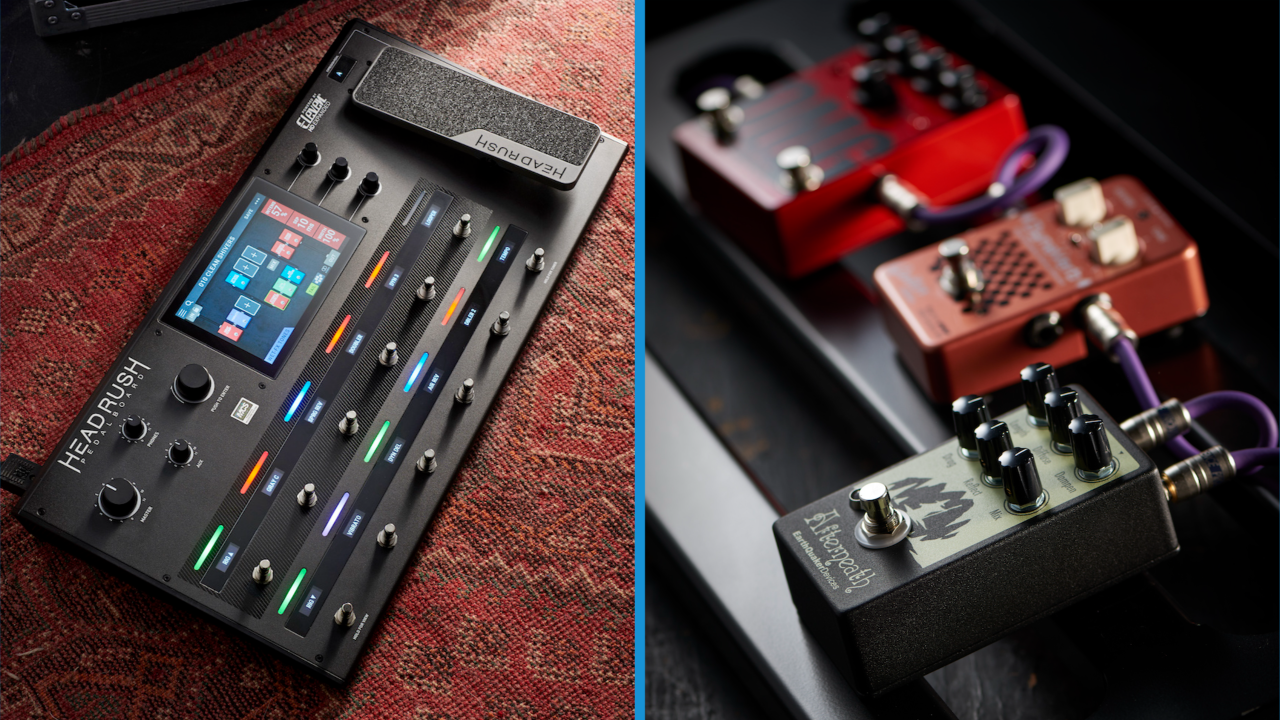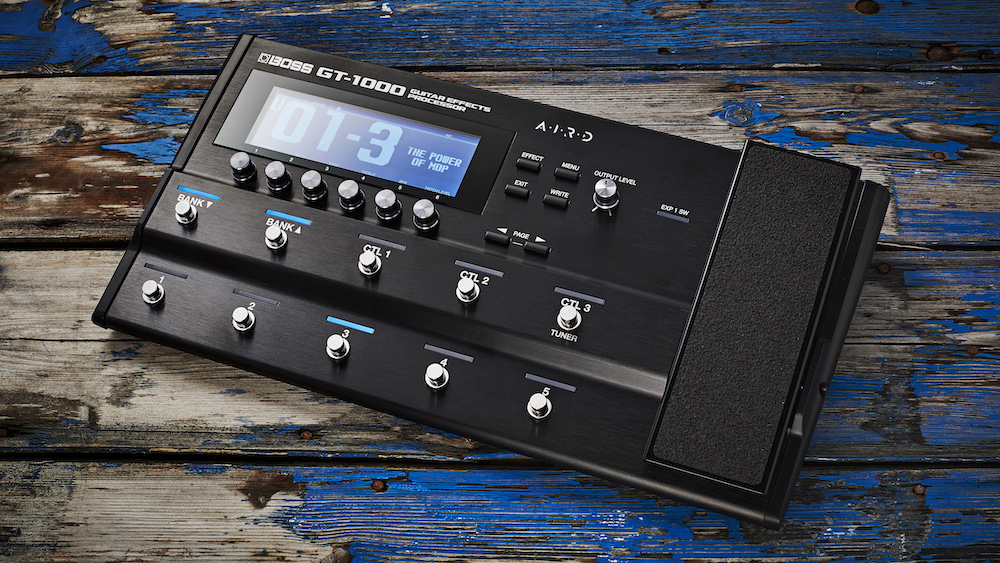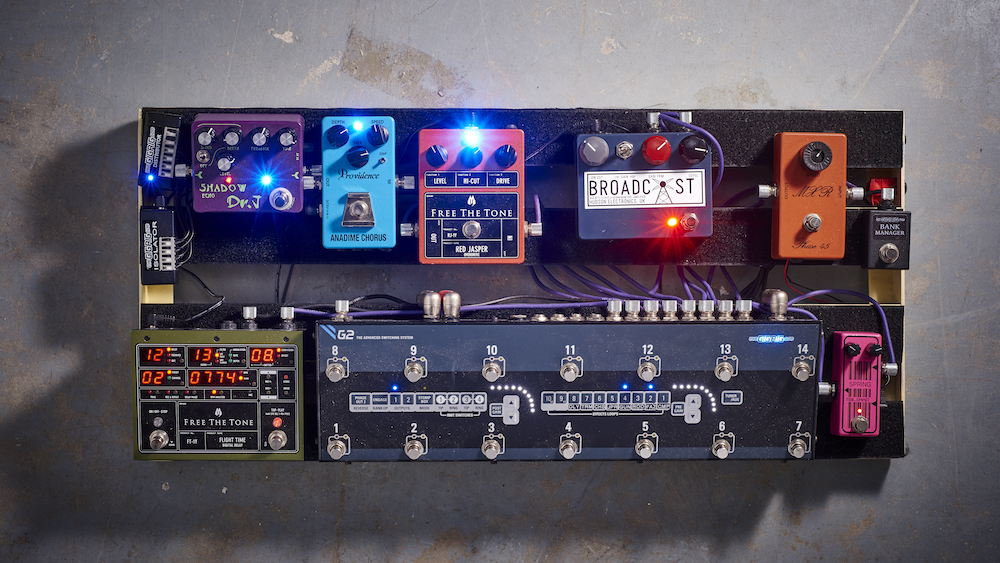Multi-effects pedal vs individual pedals: which is right for you?
We look at the pros and cons of running multi-FX versus multiple stompboxes

So where do you stand on the age-old argument of running a multi-effects pedal vs individual pedals? First we need a bit of a history lesson…
When you think about it, there's basically two main categories of guitar effect. There's effects that add gain to the signal. These generally increase the amplitude and in doing so add harmonic distortion. Enough gain, and the waveform will clip. If more clipping is desirable, diodes can be used to either 'soft-clip', or 'hard-clip' the waveform shape. This covers all boosts, drives, distortions and fuzzes.
Then there's effects that delay the signal in some way. Choruses and flangers delay a copy of the signal and manipulate it with an LFO, while delays and reverbs play it back. At the deep core of things, the same theory, maths and principles apply.
We've glossed over some utility types and filters, but you get the idea. Where we're going with this is that, by the end of the ‘90s, a single DSP (Digital Signal Processing) chip was more than powerful enough to run common algorithms for gain and delay-based effects. Since similar signal processing code was used, having many in one pedal then became just saving these algorithms to memory.
The Zoom 505 was the first of these, released in 1996, but many have since followed. It wasn't until the early 2000s however that multi-effects could really compete with discrete pedals. Not only that, but some came with amp modeling, claiming you could ditch your tube amp. Companies like Line 6 led the charge here, but for a few years, it was still more hype than reality.
The crucial thing that changed was that in the late 2010s it became possible to put much more powerful DSP chips in units, at a consumer price-point. Moreover, the same was true of the analogue-digital-analogue, or ADA conversion needed. 24bit, or even 32bit was now possible, at your feet. As a result, modern floorboards can be as powerful as rack studio gear.
Fast forward to today, and multi-effects are just a dedicated computer to process your guitar. The levels of sonic flexibility now would have been impossible twenty years ago.
Get The Pick Newsletter
All the latest guitar news, interviews, lessons, reviews, deals and more, direct to your inbox!
But are they a viable alternative to running a bunch of individual pedals? It’s complicated. Allow us to dig into the pros and cons of each approach.
Multi-FX

What is it?
As described above, a multi-effects unit is a self-contained guitar effect processor. Usually they support running multiple effects at once, in series, and sometimes also in parallel. There's often complex routing schemes on offer too. High-end units like the Line 6 Helix and Axe-FX series allow for parallel signal chains, including multiple amp setups.
As implied by this, you'll also find IR - impulse response - loading capabilities on many modern units. This allows you to model the sound of a real-life speaker cabinet to make amp simulations sound more 'alive' or 'organic'. Of course, not all amp simulations are created equal, but these days a high-end amp sim with decent IRs is indistinguishable from the real thing. The amount of Axe-FX, Kemper and Line 6 gear used live and on modern records bears this out.
Multi-FX: Pros
Flexibility This will change depending on how much you've got to spend. Some units have an incredible amount of flexibility, both in effect types and the routing options available to you. Generally, smaller or cheaper units will have less processing power. Even if complex routing options are available, as on the Line 6 HX Stomp, for example, you'll only be able to run a couple of effects at once.
Range of high-quality sounds Modern high-end units are basically indistinguishable from the pedals and amps that they model, with improvements in IR technology largely doing away with the flat and fizzy amp sims of old.
Anecdotally, we've also increasingly seen and heard of artists using cheaper floorboards in the studio. Sometimes because it is just there, and sometimes because what's more important than the sound is getting the idea down before it escapes.
Finally, there's another point - some sounds aren't things that necessarily fit your style. You might not be able to justify a wah pedal on your board, but having one available via a multi-FX might result in it breaking your writer's block one day in the future.
Having too many options can easily lead to option paralysis, but it can also leave new avenues open for you to explore at will. It's a fine line to get right, but even if you don't need them today, having the effects available might be useful.
Ergonomics Multi-effects are the most ergonomic guitar effect solution, hands down. They're compact, self-contained, easily portable, and can even replace your guitar amp entirely, both at home and in the studio. Even if you're playing smaller venues without a house PA, you can get a powered speaker or power amp and run a cabinet on-stage, with only your multi-effect in front of it.
Price Given the amount of potential sounds in a unit, there's no competition on value for money. Buying even budget mini pedals to cover the same sounds would likely be many times the cost, and that's ignoring the whole discussion of amp simulators and IRs entirely.
Multi-FX: Cons
Flexibility Multi-effects are incredibly flexible, but only in the way that they're designed to be. If you do hit the limitations of the unit, and chafe against them, then perhaps a multi-effect isn't for you. Although modern designs are intuitive and modular, they can never be as tactile or modular as compact drive and delay pedals.
Price Even if a floorboard is not that expensive compared to the average pedalboard you see on Reddit or Instagram, it's still a considerable outlay. Especially for a high-end unit, which you'll want if you intend on using amp models, you're looking at the same cost as a decent laptop.
Longevity Discrete pedals tend to have a longer shelf-life than highly technological solutions. By its very nature, cutting edge tech is soon obsolete, and in some cases, the software can be unsupported. What this means is that you might find it has a life of say, ten to fifteen years thanks to the inherent complexity of the circuitry - and even that may be generous. After all, who's using a 2000s era laptop now? Meanwhile, we have a 1987 Boss digital delay on our pedalboard, and it sounds great.
Multi-FX: anything else I should know?
There's no wrong answers, even if the choice between different multi-effects seems daunting. Simply make a shopping list of the basic features that you want, and then try a few until you find one that 'clicks'. For our money, how intuitive it is to use, and the user interface, is actually more important than the sounds. You can't tell this from a YouTube video, so try some in person if you can. Apart from that, always remember the golden rule - if something isn't contributing to achieving your creative goals, then ditch it.
Individual pedals

What is it?
At its most simple, a pedalboard is several pedals Velcro'd to an old shelf to make them easier to move around. Our first 'board was still powered by batteries, so even a power supply isn't strictly necessary.
That said, given that many modern pedals don't support a 9V battery - either for space or environmental reasons - a small pedalboard power supply is likely to be a smart purchase. Most guitarists start with something like a distortion, fuzz or overdrive, a delay or reverb, a guitar tuner and maybe a modulation of some kind. In just three or four pedals you’ll find pretty much endless combinations of potential sounds.
We've also written elsewhere about assembling a pedalboard for playing live.
Individual pedals: Pros
Flexibility There's nothing more flexible than something completely modular, and that's exactly what a pedalboard is. You can change the pedals on the board, change the order, or route them in ways that even their manufacturers didn't intend.
For example, the Digitech Whammy IV pitch shifts using a delay buffer, which introduces latency. By taking the dry out and running two amps, you could create a phase effect by manually moving the rocker. This kind of out-of-the-box thinking and experimentation isn't possible in the same way with a multi-effect.
Customization In a similar vein, a pedalboard is simply more customizable. A multi-effect is by its very nature restricted by the algorithms it has. Produced by a large musical instrument corporation, its effects are likely to be much more middle-of-the-road, focussed on covering as many bases as possible.
This means that weirdo or exotic effects are often hard or impossible to replicate using large floorboards. The kind of pedals we're thinking of are the likes of the Montreal Assembly Count to 5, Red Panda Particle or Tensor, Hologram Microcosm, Drolo Stammen or Chase Bliss Mood.
Ergonomics Although the ergonomics of pedals on a board is better than pedals on the floor, that's not the thing we want to focus on. Rather, the real ergonomic bonus of pedals over anything else is tactility. We can still remember the first time we got on the floor at a show and twisted the knobs on a Boss delay pedal to make it oscillate.
That kind of rapid feedback, with all the functions of the gear exposed immediately to the user isn't possible with a complex floor processor. User interfaces have improved, no doubt, but there's a visceral thrill that can be had from more simple, or at least more focussed or specialised gear, where all the functionality is accessible at your fingertips.
Individual pedals: Cons
Price We mentioned above a set of exotic pedals you could choose from on your ‘board. The downside is that each will set you back around $300. Unless you're going for cheap guitar pedals, or are happy with a handful for gigging purposes, a pedalboard can quickly get out of hand in terms of cost.
Our first gigging board, which served us well for five years, cost about $450, so it is possible to build an expressive and fun board without selling a kidney. However, a straw poll of guitarist friends suggests that most have 10-15 pedals on their 'board now. Possibly that's being adults with a job rather than teenagers, but it's an expensive difference.
Find out how we fared when trying to build a pedalboard on a budget.
Size As you can imagine, those 10-15 pedals take up a fair amount of space, and unless you're able to pull off some IQ 9000, 4-D chess, Tetris moves, you might struggle to fit it all. Which means a larger board, which is more money, and more space, so now you can't take the bus to a gig, so you need to get a lift from your drummer... and so on.
Individual pedals: anything else I should know?
You don't need loads of pedals to create great music. As Jim Ward (At the Drive-In, Sparta, Sleepercar) said, "a good amp, a good guitar, a delay pedal and a volume pedal, and I'm happy. [With] those four things, I've never found the end. I've never run out of ideas, I've never run out of inspiration."
Alex Lynham is a gear obsessive who's been collecting and building modern and vintage equipment since he got his first Saturday job. Besides reviewing countless pedals for Total Guitar, he's written guides on how to build your first pedal, how to build a tube amp from a kit, and briefly went viral when he released a glitch delay pedal, the Atom Smasher.
“The original Jordan Boss Tone was probably used by four out of five garage bands in the late ’60s”: Unpacking the gnarly magic of the Jordan Boss Tone – an actual guitar plug-in that delivers Dan Auerbach-approved fuzz
“This is a powerhouse of a stompbox that manages to keep things simple while offering endless inspiration”: Strymon EC-1 Single Head dTape Echo pedal review










